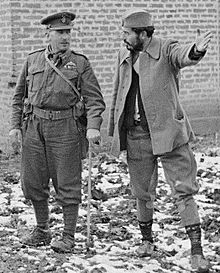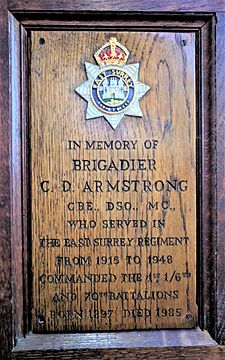Charles Armstrong (British Army officer) facts for kids
Quick facts for kids
Brigadier
Charles Douglas Armstrong
CBE DSO MC
|
|
|---|---|

Brigadier Charles Armstrong with Chetnik officer Predrag Raković, autumn 1943.
|
|
| Born | 11 June 1897 |
| Died | 11 December 1985 (aged 88) |
| Allegiance | |
| Rank | Brigadier |
| Service number | 11740 |
| Unit | East Surrey Regiment Machine Gun Corps Special Operations Executive |
| Commands held | 1/6th Battalion, East Surrey Regiment 70th (Young Soldiers') Battalion, Duke of Wellington's Regiment 1st Battalion, Duke of Wellington's Regiment |
| Battles/wars | World War I Russian Civil War World War II |
| Awards | Commander of the Order of the British Empire Distinguished Service Order Military Cross |
Brigadier Charles Douglas Armstrong (born June 11, 1897 – died December 11, 1985) was a brave British Army officer. He served in both World War I and World War II. During World War II, he led a special British mission in Yugoslavia. His job was to work with a resistance group called the Chetniks. This group fought against the Axis Powers who had taken over Yugoslavia.
Contents
Early Life and First World War
Charles Douglas Armstrong was born in 1897. He went to Cheltenham College and then to the Royal Military College, Sandhurst. In April 1915, he joined the East Surrey Regiment as an officer. This was during the First World War.
He served in France from 1916 to 1918. He was wounded twice during battles. In March 1918, he was captured and became a prisoner of war. After the war ended, he was sent home in December 1918.
Armstrong also served in North Russia in 1919 during the Russian Civil War. He was given the Military Cross award for his bravery there. Later, he served in places like Mesopotamia (now Iraq) and India.
Second World War Service
When World War II began in October 1939, Armstrong was a major. He went to France with his battalion. In April 1940, he took command of the 1/6th Battalion as a temporary lieutenant colonel.
A month later, he was part of the Dunkirk rescue. He stayed in command of his battalion until April 1942. In October 1940, he received the Distinguished Service Order for his excellent service in France.
In 1942, he commanded other battalions, including the 1st Battalion, the Duke of Wellington's Regiment. In early 1943, he took this battalion to North Africa.
Mission to the Chetniks
In July 1943, Armstrong was made a Brigadier. He was put in charge of a special British mission to the Chetniks. The Chetniks were a Serbian nationalist and royalist group led by General Draža Mihailović. They were one of the main resistance groups in occupied Yugoslavia.
Armstrong parachuted into Yugoslavia in September 1943. He faced a difficult situation. The Chetniks were upset with the British. The United Kingdom had been sending many supplies to the Communist forces, who were rivals of the Chetniks.
Misreporting of Chetnik Actions
The BBC often gave credit to the Communist forces for actions that the Chetniks had done. For example, in September 1943, the Chetniks attacked the German army in Prijepolje. They killed 200 German soldiers and captured the town. However, the BBC said that Tito's Communist Partisans had won this victory.
Soon after Armstrong arrived, he saw the Chetniks attack Višegrad. They destroyed a railway bridge over the Drina. This was the longest bridge destroyed by resistance fighters in occupied Yugoslavia. British engineers even helped with the destruction.
Despite this, the British media, including the BBC, again gave credit to the Communist Partisans. Armstrong and others protested, but the BBC did not correct the information.
The Chetniks also captured Rogatica in October 1943. They killed over 200 Axis soldiers. Again, the BBC credited the Communist forces. In November, the Chetniks attacked Nova Varoš and Kalna. These actions were also wrongly credited to the Communists. Armstrong sent angry protests to the BBC, but nothing changed.
Challenges and Supply Issues
Armstrong's mission was to convince Mihailović to increase his anti-Axis activities. However, the British were not providing enough supplies to the Chetniks. By December 1943, the British army had sent only 30 tons of weapons to the Chetniks. In contrast, they sent 18,000 tons to the Communist Partisans. The Partisans often used these British weapons to fight the Chetniks.
Armstrong once said:
Poor Mihailovic had not got the weapons to fight the Germans with all their modern weapons: his supply depended on what his forces could capture. I remember particularly two air-drops at my HQ, one consisted mainly of gumboots [rubber boots], the other of office equipment.
Armstrong was also unhappy because the Chetniks refused to destroy certain bridges. He insisted that they destroy bridges over the Morava and Ibar rivers. He made this a condition for his participation in a meeting called the Ba Congress. Because the Chetniks refused, Armstrong did not attend the Congress.
After his mission in Yugoslavia, Armstrong returned to England in June 1944. He then commanded the British Airborne Liaison Unit for the Polish Parachute Brigade. He stayed in the UK for the rest of the war.
After the War

In January 1945, Armstrong was made a Commander of the Order of the British Empire (CBE). This was for his important service during the war. In August 1945, he took command of the 1st Battalion, East Surrey Regiment in Austria.
He returned to England in November 1946. He then commanded a prisoner of war camp for German soldiers. He retired from the army in December 1948 with the honorary rank of Brigadier.
In his retirement, he lived in Camberley, Surrey. He was also a member of the Special Forces Club. Charles Douglas Armstrong passed away on December 11, 1985, at the age of 88. There is a special memorial plaque for him in the East Surrey Regiment Chapel. This chapel is located in All Saints Church, Kingston upon Thames.

